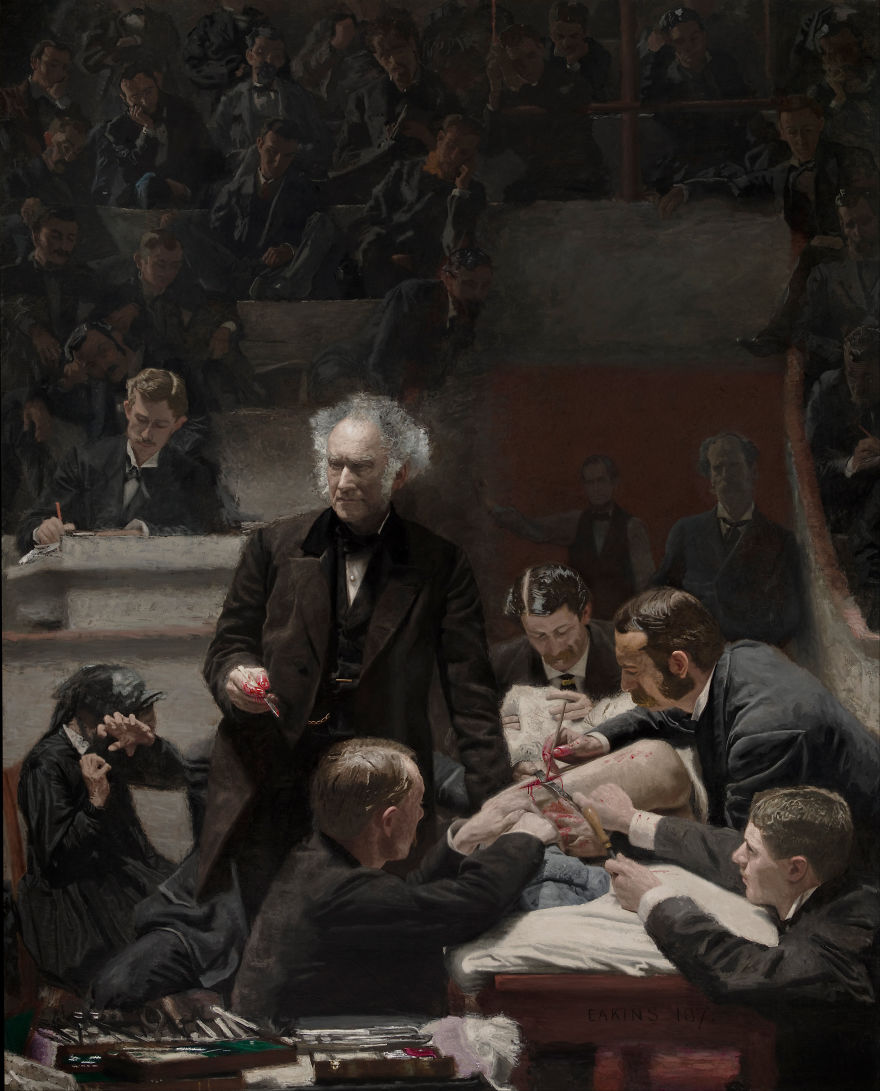While I'm no expert in art history, I find the backstories to famous artworks to be really interesting. So, I wanted to share more interesting stories with you all.
If you are interested, you can find my previous art stories here and here.
This post may include affiliate links.
Starry Night, Vincent Van Gogh, 1889
In the aftermath of a mental breakdown that resulted in the self-mutilation of his left ear, Van Gogh voluntarily admitted himself to the Saint-Paul-de-Mausole lunatic asylum in 1889. During this period, he produced some of the best-known works of his career, including “Irises” and the blue self-portrait. "The Starry Night" shows the view from the east-facing window of his room at the asylum just before sunrise, with the addition of an idyllic village.
It's not the exact same view, but close. I've been in that room and you can see the mountains from there, but not the city or the church. They say it's probably a memory from when he had been outside.
The Great Wave Off Kanagawa, Katsushika Hokusai, 1829 – 1833
The composition comprises three main elements: the sea whipped up by a storm, three boats, and a mountain. The mountain with a snow-capped peak is Mount Fuji, which in Japan is considered sacred and a symbol of national identity, as well as a symbol of beauty. Using the boats, with their thirty passengers, as a reference, we can see the wave must be close to 12 meters tall. The wave, which curls around like a claw to frame Mount Fuji, shows the artist’s awe and fear of the unpredictable sea.
I thought the background info on this painting would be that Hokusai painted it later in life (he's thought to have been in his seventies at the time), more or less forced back into work to pay off his grandson's debts. While that's a sad fact, it's also inspiring to me that sometimes you can create your best work even when older.
The Scream, Edvard Munch, 1893
Munch was out for a walk at sunset when the setting sunlight turned the clouds a blood red. He sensed as he put it, an “infinite scream passing through nature.” It has been suggested a volcanic eruption could have attributed to the unnaturally orange sky. Another explanation could have been the result of Munch’s emotional state, as his sister had very recently been committed to a lunatic asylum. Munch created four versions in paint and pastels, as well as a lithograph stone from which several prints survive. Both of the painted versions have been stolen and recovered. One of the pastel versions commanded the fourth highest nominal price paid for a painting at a public auction.
I had the privilege of seeing this painting in person. I can't believe it was painted in cardboard. All of the brown is actually the background showing through.
Des Glaneuses, Jean-François Millet, 1857
"Des glaneuses" ("The Gleaners") depicts three peasant women gleaning a field of stray stalks of wheat after the harvest. The painting is famous for featuring the lowest ranks of rural society in a sympathetic way. When Millet unveiled the piece in 1857, it immediately drew negative criticism from the upper classes. France had recently come out of the 1848 Revolution, and the upper class saw the painting as a reminder that French society was built upon the labor of the working masses, one of the tenants of the growing Socialist movement. At the time, the working class outnumbered the upper class, and there were concerns the painting might spur the lower class to revolt. With the Revolution still fresh on the minds of the upper classes, this painting was not perceived well at all.
Der Wanderer Über Dem Nebelmeer, Caspar David Friedrich, 1818
"Der Wanderer über dem Nebelmeer" ("Wanderer above the Sea of Fog") is true to Friedrich’s Romantic style. It has been said the painting expresses a metaphor for self-reflection as well as the unknown future. In regards to the subject’s position, Friedrich stated, “The artist should paint not only what he has in front of him but also what he sees inside himself."
Susanna And The Elders, Artemisia Gentileschi, 1610
"Susanna and the Elders" shows an uncomfortable Susanna with the two men lurking above her while she is in the bath. The subject is a story from the Book of Daniel, depicting a scene where two elderly men spy on a young woman named Susanna in a garden bath. The two elders demanded sexual favors from her. When Susanna refused, they tried to ruin her reputation until a young man named Daniel intervened. He suggested the men be questioned separately. Their stories did not coincide with each other, so Susanna’s name was cleared.
This part of Daniel is considered apocryphal by some and is not included in non-Catholic/Orthodox Bibles.
The Gross Clinic, Thomas Eakins, 1875
This painting is based on a surgery witnessed by Eakins, in which Dr. Samuel Gross treated a young man for an infection of the femur with conservative surgery rather than amputation (standard for the time). A crowd of doctors surrounds the patient as Dr. Gross lectures, with a clinic clerk over his shoulder taking notes. Sitting to Dr. Gross’s left is a lone woman, the patient’s mother, recoiling in horror. The painting has an important place in the history of medicine, because of its role in the emergence of surgery as a healing profession (as opposed to a means for amputation), and because it shows what the surgical theater looked like in the nineteenth century.
Barge Haulers On The Volga, Ilya Repin, 1873
This work is a condemnation of profit from inhumane labor. Although they are presented as stoic and almost accepting of their fate, the men look rather defeated. Only the youngest is a brightly colored youth standing upright and fighting against his leather binds. Repin conceived the painting during his travels through Russia, and it depicts the actual characters he encountered. The piece drew international praise for its realistic portrayal of the hardships of working men and launched his career.
Jacques Sandalescu was abducted at 16, forced to work in the coal mines of Russia. His book 'Donbas' tells it.
The Raft Of Medusa, Théodore Géricault, 1819
"The Raft of Medusa" ("Le Radeau de la Méduse") depicts the aftermath of the wreck of the French naval frigate Méduse. At least 147 people were set adrift on a hurriedly constructed raft; all but 15 died in the 13 days they awaited rescue. Those that survived endured dehydration and starvation to the point of practicing cannibalism. The event became an international scandal, in part due to the perceived incompetence of the captain of the Méduse.
The Potato Eaters, Vincent Van Gogh, 1885
Van Gogh wanted to depict peasants as they really were, and deliberately chose models who were coarse in aesthetics. He wanted to show a wholly different way of life from the upper classes. He later wrote to his sister and claimed "The Potato Eaters" to be his most successful painting.
I actually do prefer this to some of his more famous work; it shows much more emotion than say Starry Night I think, also the colors and harsh lighting contrasts on the angles of their faces contribute to a particularly interesting aesthetic
A Friend In Need, Cassius Marcellus Coolidge, 1903
"A Friend in Need" is the most popular painting of the "Dogs Playing Poker" series by Cassius Marcellus Coolidge. The series was originally commissioned by Brown & Bigelow to advertise cigars. All eighteen paintings featuring anthropomorphized dogs, with eleven depicting card games. While Coolidge’s paintings were never considered genuine art by critics, they have since become iconic, with the first of the series, "Poker Game", recently selling at Sotheby’s for $658,000.
Stag Night At Sharkey’s, George Wesley Bellows, 1909
"Stag at Sharkey's" depicts two boxers fighting in the private athletic club situated across from Bellow’s studio. Participants were usually members, but occasionally outsiders, known as “stags,” would get a temporary membership and fight. The piece is part of the Ashcan School movement, known for depicting daily life in early twentieth-century New York, usually in the poorer neighborhoods. Bellows used quick strokes to create a blurred image of two fighters in motion. He chose a low point of view to put the viewer among the crowd watching the fight.
Saturn Devouring His Son, Francisco Goya, 1823
"Saturn Devouring His Son" depicts the Greek myth of the Titan Cronus (Romanized to Saturn), who, fearing that he would be overthrown by one of his children, ate each one upon their birth. The work is one of the 14 Black Paintings that Goya painted directly onto the walls of his house.
Composition Viii, Wassily Kandinsky, 1923
Kandinsky had been fascinated with color from an early age, considering it to have transcendental properties. The artist wished to explore an interrelation between sound and color in the same way a musician composes a song. The use of circles, grids, rectangles, semicircles, triangles and other mathematical forms in the artwork is consistent with the painter's belief in the mystical properties of geometric shapes while the colors were chosen for their emotional impact.
Watson And The Shark, John Singleton Copley, 1778
"Watson and the Shark" depicts the rescue of a boy from a shark attack in Havana, Cuba in 1749. Brook Watson, then a 14-year-old cabin boy on the Royal Consort, lost his leg in the attack and was not rescued until the third attempt, which is the subject of the painting.
Cardsharps, Caravaggio, 1594
The players of a game of primero (pre-poker), consist of a dupe and two cardsharps engaged in a con. Caravaggio has treated this subject not as a caricature of vice but in a novelistic way, in which the interaction of gesture and glance evokes the drama of deception and lost innocence in the most human of terms.
The Garden Of Earthly Delights, Hieronymus Bosch, 1490-1510
Little is known of Bosch's life or intentions, but the intricacy of its symbolism, particularly that of the central panel, has led to a wide range of scholarly interpretations. Twentieth-century art historians are divided as to whether the triptych's central panel is a moral warning or a panorama of paradise lost. Peter S. Beagle describes it as an erotic derangement that turns us all into voyeurs.
Like Hokusai's works, except Bosch's are centuries older, wich is even more amazing, they look so modern; you could absolutely believe that they belong to artists of the 21st century, and that speaks to the genius of these masters. The more you look at these the more awed and fascinated you become...
The Bath, Jean-Léon Gérôme, 1885
Gérôme’s European prejudices are undeniable in the dynamic between the two figures in "The Bath". The paler female nude, which Gérôme clearly based upon European women, is attended to by a darker-skinned slave. Setting up a hierarchy of skin tone. The paler woman is to be objectified, while the woman of color takes on a submissive role. Since there was no way for Gérôme to have been allowed in these very private female spaces, it can be assumed this piece reflects the artist’s own prejudices.
This is not an intriguing story about the painting, just your opinion of it. First, Gérôme was part of the Orientalist movement, which depicts mostly imagined scenes of a fantasized North Africa and Middle East. Second, no it is not just the artist's own prejudices: many slaves in the Ottoman empire (and other countries of this part of the world) were black, and people from Turkey, Arabia peninsula, Maghreb are lighter-skinned. Thinking she is a European woman is your own prejudice. Third, remove the paintings with naked women and you won't have much left in museums. Whether it is art or objectification is a heated discussion. Your other comments were much better built than this one.
J'aime La Couleur, Chèri Samba, 2003
In "J'aime la couleur", the artist's head is portrayed as a winding spiral against a bright blue sky. He holds a dripping paintbrush between his teeth. The work is an expression of how Samba equates color to life. “Everything is color,” he says, and the spiraling portrait conveys how we must unravel to see the color in our lives.
St. George And The Dragon, Paolo Uccello, 1470
"Saint George and the Dragon" shows off the gothic tendencies in Paolo Uccello's art. Within the painting is a scene from the famous story of the same name, with George spearing the beast on the right and a princess using a lead to take it to town. Devine intervention is indicated with the storm gathering on the right of Saint George. The painting was the inspiration for the U. A. Fanthorpe poem, “Not My Best Side,” and for Sir John Tenniel's illustration of the Jabberwock in “Through the Looking-Glass,” and “What Alice Found There.”
I absolutely love your art posts. I lays wind up spending a few hours doing more research on the artwork you feature. Thank you!
I really liked this article — it was informative and interesting to read! More please!
Alexander Calder was trying to create 3D kinetic versions of Piet Mondrian's "Studies in Color" series when he invented the mobile.
I love it! Some I didn't know, like Bellows. That painting is what's happening here and now too. Labor class vs Economy's elite.
I absolutely love your art posts. I lays wind up spending a few hours doing more research on the artwork you feature. Thank you!
I really liked this article — it was informative and interesting to read! More please!
Alexander Calder was trying to create 3D kinetic versions of Piet Mondrian's "Studies in Color" series when he invented the mobile.
I love it! Some I didn't know, like Bellows. That painting is what's happening here and now too. Labor class vs Economy's elite.

 Dark Mode
Dark Mode 

 No fees, cancel anytime
No fees, cancel anytime 















































































